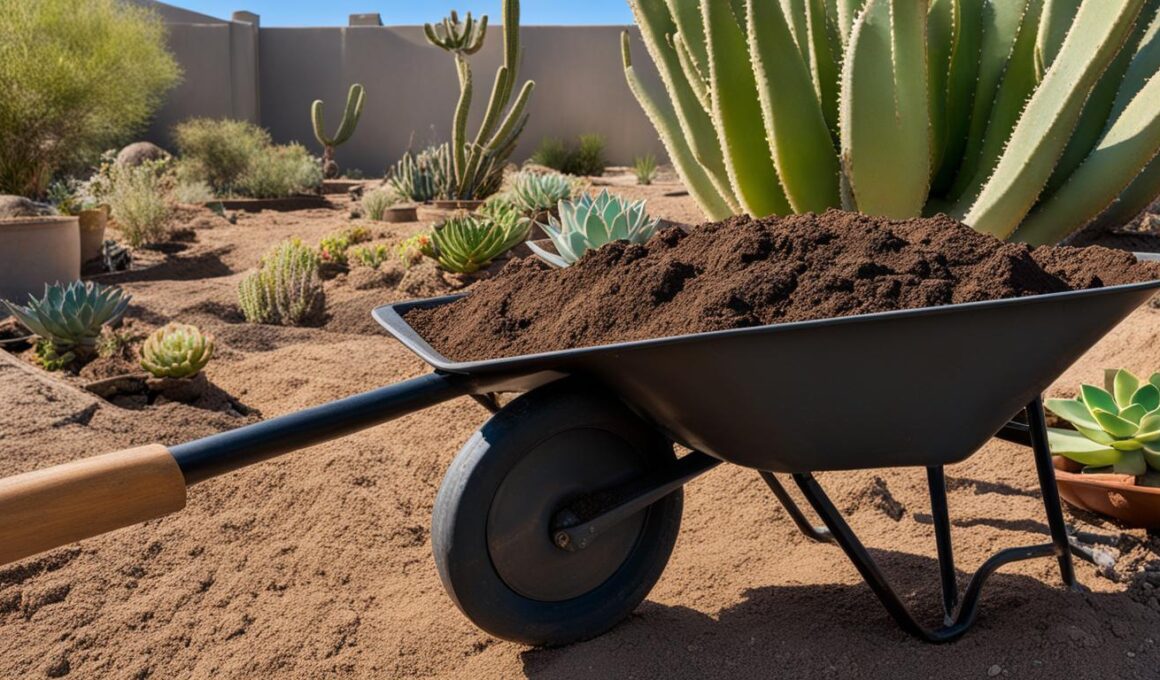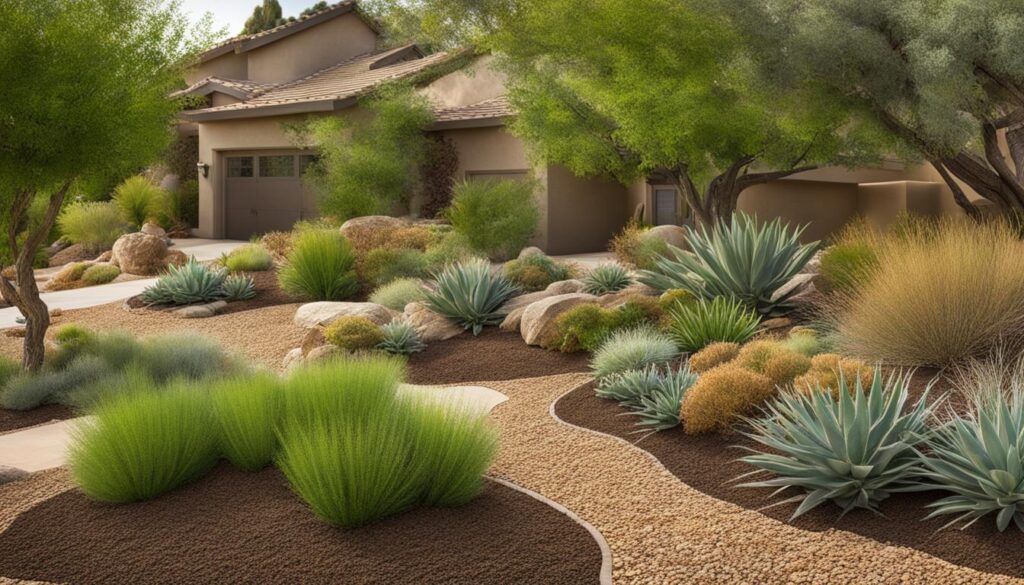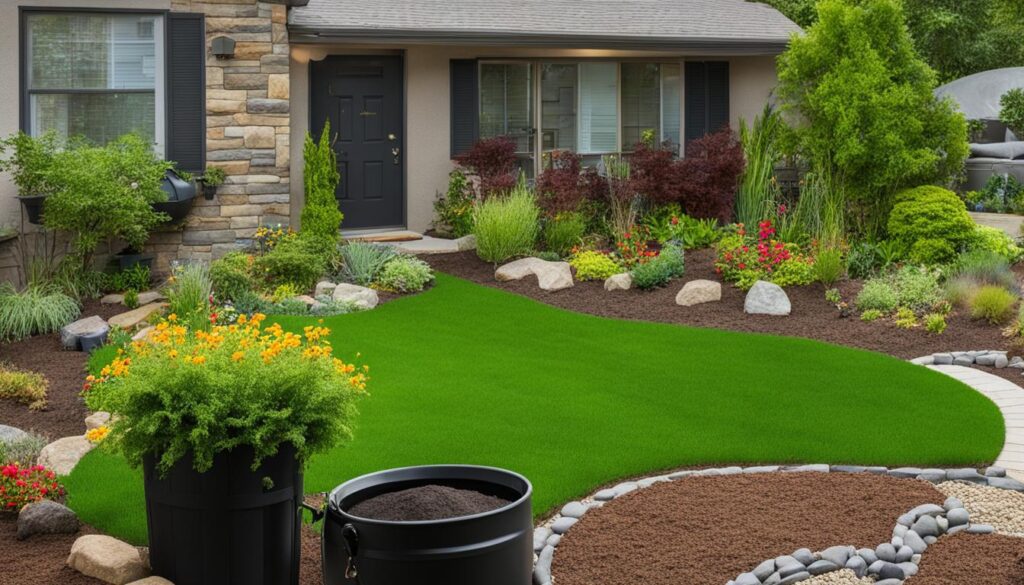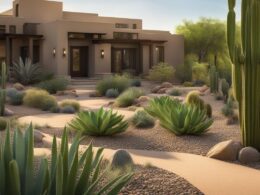Xeriscaping is a drought-tolerant landscaping method that focuses on conserving water by using as little water as possible to maintain your yard. To achieve effective xeriscaping, proper soil preparation is crucial. By following the principles of xeriscaping, including planning and design, soil improvements, efficient irrigation, plant zones, mulching, turf alternatives, and maintenance, you can create a low-maintenance and water-saving landscape. Xeriscaping is especially beneficial in drought-prone areas like California, Arizona, Nevada, and Colorado. By reducing water usage through xeriscaping, you not only help conserve water but also save money on your water bill.
Key Takeaways
- Proper soil preparation is essential for effective xeriscaping.
- Xeriscaping helps conserve water and save money on water bills.
- By following the principles of xeriscaping, you can create a low-maintenance landscape.
- Xeriscaping is especially beneficial in drought-prone areas.
- Reducing water usage through xeriscaping contributes to water conservation efforts.
What is Xeriscaping and its Benefits?
Xeriscaping is a landscaping method that aims to use as little water as possible to maintain a yard. It is particularly popular in drought-prone areas. By incorporating xeriscaping principles such as efficient irrigation, drought-tolerant plant selection, and proper soil improvements, you can reduce water usage for your yard by up to 50%. Xeriscaping also offers numerous benefits, including lower water bills, low maintenance, increased return on investment (ROI), and the preservation of natural ecosystems. By planting native plants, you can support local wildlife and contribute to biodiversity. Additionally, xeriscaping helps mitigate the impacts of climate change by reducing the strain on water resources and promoting resilience in changing weather patterns.
“Xeriscaping not only helps conserve water but also creates visually appealing landscapes that require less maintenance and financial investment in the long run,” says Jane Smith, a landscape architect with expertise in xeriscaping. “By choosing drought-tolerant plants and implementing efficient irrigation techniques, homeowners can create beautiful, sustainable yards while reducing their environmental impact.”
In addition to its environmental benefits, xeriscaping can also save you time and money. With less watering, mowing, and maintenance required, you can spend more time enjoying your outdoor space and less time on yard work. Lower water bills are another advantage of xeriscaping, as it minimizes the need for regular irrigation.
Benefits of Xeriscaping:
- Water Conservation: Reduces water usage by up to 50% through efficient irrigation and drought-tolerant plant selection.
- Lower Water Bills: Minimizes the need for regular watering, resulting in cost savings on water bills.
- Low Maintenance: Requires less time and effort for mowing, weeding, and maintenance compared to traditional landscapes.
- Increased ROI: Adds value to your property by creating an attractive and sustainable landscape.
- Preservation of Natural Ecosystems: Supports local wildlife, contributes to biodiversity, and reduces the strain on water resources.
By embracing xeriscaping, you can transform your outdoor space into a beautiful, water-efficient landscape that reflects your commitment to sustainability. With its practical benefits and environmental advantages, xeriscaping is a smart choice for homeowners seeking a low-maintenance, eco-friendly solution.
The Seven Principles of Xeriscaping
Xeriscaping follows seven principles to create a sustainable and water-efficient landscape. By understanding and implementing these principles, you can create a beautiful and low-maintenance yard that conserves water and supports the environment.
1. Planning and Design
Begin by creating a landscape plan that takes into account the layout, elements, and zones of your yard. Consider factors such as sun exposure, water availability, and the needs of different plant species. By strategically placing plants and hardscape elements, you can maximize water efficiency and create an aesthetically pleasing design.
2. Soil Improvements
Proper soil preparation is crucial for xeriscaping success. Add organic compost and mulch to improve the soil’s ability to retain water and enhance drainage. This helps prevent water runoff and allows plant roots to access moisture more efficiently. Additionally, amending the soil can improve nutrient availability for plants, ensuring their health and vitality.
3. Efficient Irrigation
Efficient irrigation practices are essential for conserving water in xeriscaping. Water plants’ roots deeply and infrequently to promote healthy growth and reduce water evaporation. Utilize drip irrigation systems or soaker hoses to deliver water directly to the root zone. Avoid watering during the hottest part of the day when evaporation rates are high, and consider installing rain sensors or soil moisture sensors to optimize watering schedules.
4. Plant Zoning
Group plants with similar water and sunlight needs together in designated zones. This allows for more efficient watering and ensures that each plant receives the appropriate amount of sunlight. By strategically planning plant placement, you can reduce water waste and create a visually appealing landscape.
5. Mulching
Mulching plays a vital role in xeriscaping by reducing water evaporation and suppressing weed growth. Apply a layer of organic or inorganic mulch around plants to help retain moisture in the soil. Mulch also helps regulate soil temperature and protects plant roots from extreme heat or cold.
6. Turf Alternatives
Consider replacing traditional lawns with drought-tolerant turf alternatives. Native low-water plants, such as succulents, ornamental grasses, and wildflowers, require significantly less water than grass. These plants not only reduce water usage but also add visual interest and diversity to your landscape.
7. Maintenance
Xeriscape yards are generally low maintenance, but regular upkeep is still necessary. Perform periodic maintenance tasks such as weeding, pruning, and mulch replenishment. Monitor your irrigation system to ensure it is functioning correctly and adjust watering schedules as needed. By dedicating some time to maintenance, you can keep your xeriscape thriving and looking its best.
Implementing these principles of xeriscaping can transform your landscape into a water-efficient and visually appealing oasis. By planning and designing thoughtfully, improving the soil, using efficient irrigation methods, zoning plants effectively, mulching, considering turf alternatives, and maintaining your xeriscape, you can create a sustainable and low-maintenance yard that conserves water and supports the environment.
Xeriscaping on a Budget and Turf Replacement Rebate Programs
Xeriscaping is not only an environmentally friendly landscaping method but also a cost-effective way to beautify your yard. If you are on a budget, there are several strategies you can employ to keep the costs low while still achieving a stunning xeriscape design. One of the first steps is to consider designing your backyard yourself and doing the physical labor. By doing so, you can save money on hiring professionals and invest those savings into other aspects of your xeriscaping project.
When it comes to plant selection, consider buying seeds and plant cuttings instead of mature plants. This not only saves money but also allows you to experiment with a wider variety of plants. Opting for plants that spread quickly can also be a cost-effective choice as they will fill in your landscape more rapidly. Additionally, native plants are often less expensive and require less water and maintenance.
Another way to save money on xeriscaping is by utilizing cost-effective elements in your design. Instead of purchasing new concrete slabs and boulders, consider using shells and pebbles as alternative hardscape materials. Making your own mulch from fallen leaves or tree trimmings can also help reduce expenses. These DIY approaches can significantly cut down on the overall cost of your xeriscaping project.
Furthermore, several states, like California and Colorado, offer turf replacement rebate programs to incentivize homeowners to replace their lawns with water-wise alternatives. These programs provide financial incentives for homeowners who choose to remove their water-intensive turf and replace it with xeriscaping. Taking advantage of these programs not only helps you save money upfront but also contributes to water conservation efforts in drought-stricken areas.
With some creativity, thoughtful planning, and the availability of turf replacement rebate programs, xeriscaping on a budget can be a reality. By incorporating cost-effective strategies and taking advantage of monetary incentives, you can transform your landscape into a beautiful, water-efficient space without breaking the bank.
How Does Soil Preparation Contribute to the Benefits of Xeriscaping in Arid Climates?
Proper soil preparation is crucial to maximizing the benefits of xeriscaping in arid climates. Adding organic matter and improving soil structure can enhance water retention, reduce evaporation, and increase plant resilience, all of which contribute to the benefits of xeriscaping in arid climates.
Conclusion
Xeriscaping offers numerous benefits, making it a sustainable landscaping method that promotes water conservation and creates visually appealing yards. By following the principles of xeriscaping, you can significantly reduce your water usage and contribute to the preservation of natural ecosystems. With xeriscaping, you can enjoy lower water bills and spend less time and effort on maintenance tasks.
In drought-prone areas, xeriscaping is especially advantageous, as it helps mitigate the strain on water resources and promotes resilience in changing weather patterns. By implementing efficient irrigation practices, choosing drought-tolerant plants, and improving your soil quality, you can create a landscape that thrives with minimal water requirements.
Whether you choose to hire professionals or embark on a DIY xeriscaping project, the benefits of xeriscaping make it a worthwhile investment. By taking the first steps in soil preparation for effective xeriscaping, you can transform your landscape into a sustainable and water-conserving oasis, while also saving time, money, and valuable natural resources.












